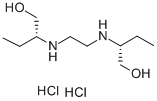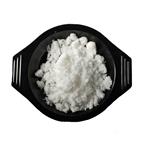Chemical Properties
White Powder
Originator
Myambutol,Lederle,US,1967
Uses
Antibacterial (tuberculostatic)
Uses
Ethambutol dihydrochloride it acts as a tuberculostatic antibacterial agent. It is used to treat tuberculosis in combination with other antibiotics to reduce the development of drug resistance. It has been used to study multidrug-resistant tuberculosis (MDR-TB) in highest-incidence-rate.
Definition
ChEBI: The dihydrchloride salt of ethambutol. A bacteriostatic antimycobacterial drug, it is effective against Mycobacterium tuberculosis and some other mycobacteria. It is used in combination with other antituberculous drugs in the treatment of pulm
nary and extrapulmonary tuberculosis; resistant strains of M. tuberculosis are readily produced if ethambutol dihydrochloride is used alone.
Manufacturing Process
To 27 grams (2.55 mols) of 2-amino-1-butanol was added 100 grams (1.0
mol) of ethylene dichloride. The mixture was heated at reflux and in a few
minutes, the exothermic reaction required the removal of exterior heating.
After 10 minutes, exterior heating was recommenced for an additional 20
minutes. The hot mixture was then treated with 300 ml of methanol and then
cautiously with 84 grams (2.1 mols) of sodium hydroxide in 80 ml of water.
The precipitated sodium chloride was removed by filtration. The excess 2-
amino-1-butanol distilled as light yellow oil at 83° to 87°C/13 mm. The
viscous residue distilled at 165° to 170°C/0.6 mm as a light yellow oil which
tended to solidify in the air condenser; yield, 108 grams.
Recrystallization by dissolving in 80 ml of hot ethanol, adding about 150 ml of
petroleum ether (BP 90° to 100°C) and cooling at 5°C overnight, gave 64
grams of white crystals melting at 128° to 132.5°C. This, on recrystallization
from 100 ml of 95% ethanol, gave 35 grams of white crystals melting at
134.5° to 136°C and a second crop of 10 grams melting at 132.5° to 134°C
which is the meso base. Its dihydrochloride melts at 202° to 203°C.
From the ethanolic filtrates upon addition of 130 ml of about 4 N ethanolic
hydrochloric acid and cooling, there was obtained 55 grams of white crystals
melting at 176.5° to 178°C and a second crop of 10 grams melting at 171.5°
to 174.5°C. This is the dl racemate dihydrochloride.
brand name
Myambutol (Stat Trade).
Therapeutic Function
Antitubercular
General Description
Pharmaceutical secondary standards for application in quality control provide pharma laboratories and manufacturers with a convenient and cost-effective alternative to the preparation of in-house working standards
Biochem/physiol Actions
Ethambutol is bacteriostatic against actively growing TB bacilli. Mycolic acids attach to the 5′-hydroxyl groups of D-arabinose residues of arabinogalactan and form mycolyl-arabinogalactan-peptidoglycan complex in the cell wall. Ethambutol disrupts arabinogalactan synthesis by inhibiting arabinosyltransferases, specifically those in Mycobacterium, interfering with the biosynthesis of arabinogalactans found in the cell wall of mycobacteria and leading to increased cell wall permeability.
Clinical Use
Antibacterial agent:Tuberculosis
Metabolism
Ethambutol is partially metabolised in the liver to the
aldehyde and dicarboxylic acid derivatives, which are
inactive.Up to 80% of a dose appears in the urine within 24
hours, 50% as unchanged drug and 8-15% as the inactive
metabolites. About 20% of the dose is excreted unchanged
in the faeces.




